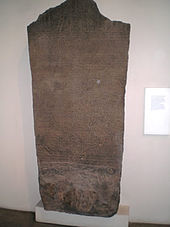Hamadab

Hamadab is the name of a place in Sudan where the remains of an ancient city are located.
The name was borrowed from the nearby village of Dumat al Hamadab , as the ancient name of the city is initially unknown.
The ancient city of Hamadab is about 3 km south of Meroe and can therefore almost be described as a suburb of Meroe, also an uninhabited ruined city.
The field of ruins today consists of two hills (200 × 250 m and 250 × 500 m), and is therefore about the same size as Meroe. The two hills are separated by an arm of the Nile , which, however, has no water in winter. They are about four meters higher than the land on the banks of the Nile. In the northeast of the two settlements a temple was excavated in 1914 , in front of which there were two steles of Queen Amanirenas and Akinidad . The god worshiped in the temple is unknown. It was Amun suspected.
More recent excavations in Hamadab have been taking place since 2001. Accordingly, the urban area was densely built up with adobe houses and surrounded by a wall. Their origins are so far unknown. The city seems to have been abandoned in the 4th century AD.
literature
- Pawel Wolf: Hamadab - The Akinidad's Headquarters? In: The ancient Sudan. 15, 2004, ISSN 0945-9502 , pp. 83-97 ( PDF ).
Web links
- Archeology Online: Annett Dittrich, Kerstin Geßner: From the stele to the city: excavations in Hamadab / Sudan
- Hamadab - The Akinidad's Headquarters? ( Memento from November 12, 2010 in the Internet Archive )
Coordinates: 16 ° 54 ′ 42 " N , 33 ° 41 ′ 31" E